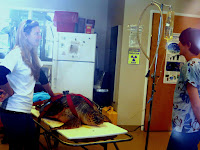 |
| Feeling better! Turtle Rehab Center, Juno Beach, Fl. |
We have four species that return to our area: loggerhead, leatherback, green, and hawksbill. Since artificial lighting discourages the females from nesting on the beach, there is an ordinance in Florida (and fine for offenses) that all outside lights must be turned off or inward during nesting season.
The females' tracks are as big as a tractor's tire marks. They dig holes in the sand, lay around one hundred golf-ball size eggs, cover the hole with sand, and spread sand over a large area to disguise the hole. Then they reenter the water. Although I have seen the track marks in the sand, I have never witnessed the nocturnal nesting.
Incubation will last 45-55 days. The hatchlings will use reflections from the moon to find their way to the water at night. Only one out of a thousand will survive the predators and the tides.
 |
| Sick turtle getting an IV at Juno Beach Rehab Center, Fl. |
 |
| Wheelchair for sick turtles, Juno Beach Turtle Rehab Center, Fl. |
In our area of beach, a non-profit called Sea Turtle Adventures provides daily monitoring of the nests on a three-mile stretch. They stake the nests, relocate them as needed, and excavate them after hatching. The group also provides documentation and reporting of predation events, offensive artificial lighting in the evening during nesting season, and obstructed nesting attempts. It co-ordinates efforts to document and transport dead or injured sea turtles to a rehabilitation facility (such as the Juno Beach Center), and provides annual reports to the Florida Fish and Wildlife Conservation Commission.


Thanks for post:
ReplyDeleteship hàng hóa sang Togo
ship tốc độ sang Chad
chuyển hàng hóa tới Chad
I like turtles They are the quietest pets.
ReplyDeleteBuy Discount Tickets
Buy Cheap Tickets